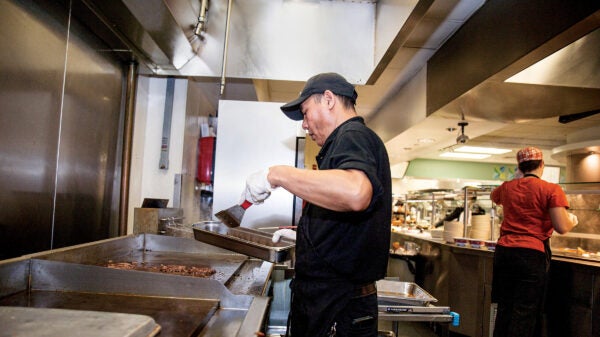As a graduate student, Marilyn Tyus bustled about between stacks of books as she chipped away at a master’s degree in psychological counseling at Southeast Missouri State University. Between her studies, she worked at the university’s diversity office. Then she received a call. Amid campuswide staff resignations, the dean pleaded with her to switch posts and run a residence hall. As faculty and staff dwindled, dorms were left masterless and underresourced as the incoming semester loomed. Tyus promptly declined. Some students might be eager to start their college experience by plotting secret parties and sneaking in contraband. She wanted no part in it.
Morning after morning, the dean stopped by her office, pleading for her aid. Still, she said no. In an attempt to coax her into taking the position, he went on almost endlessly, listing all the job perks she could have, such as free parking, a rent-free apartment and a complimentary meal plan. Finally, Tyus asked, “Where do I sign up?”
After stints in housing services around the country, she landed at the University of Michigan. During that time, the University of California San Diego rang her daily for recruitment, but she was loyal to her dream of retiring in Michigan and had no desire to live in the Golden State. She reached out to an old friend Hemlata Jhaveri — the former vice president of housing and dining at UT — knowing that she was the right fit for the California job. Once her friend accepted the position, she nudged Tyus to fill the vacancy at UT. Without any expectations, Tyus agreed to the interview.
“I had such a great time when I came here, and you know when you know,” Tyus says. “It just felt right. And while I was planning to retire from Michigan, I just changed. And I haven’t regretted it. I haven’t regretted it one bit.”
Tyus, now associate vice president of University Housing and Dining, has seen every rung of the housing and dining ladder. With 32 years of experience, she’s learned that she loves influencing what students engage in and making a daily impact on their lives. She knew she couldn’t do it alone, so she recruited Erich Geiger, executive director of residential dining and Longhorn hospitality, and Keith Morrison, director of culinary, to help bring her plans to fruition.
“I loved working with students,” Tyus says. “I fell into it — literally fell into housing — and have been in housing ever since.”
She began working at UT in July 2018. One month later, an eye-opening edition of The Daily Texan hit her desk. In an article, upperclassmen were advising freshmen how to strategically eat so their Dine In Dollars would last all year. The meal plan was previously based on the Dine In Dollars system, which meant each time a student went to a dining hall, the transaction would take money from their pool.
Rushing to her team, Tyus declared within the next year that there would be an all-you-care-to-eat dining operation, ensuring that students will never have to worry about when they would or could eat next.
“I told my staff … (that students) shouldn’t have to worry about am I going to have have enough food? I shouldn’t have to worry about my students skipping breakfast so they can make sure to have dinner and lunch,” she says.
In 2019, Tyus initiated the open access plan at UT, putting all residents on the same unlimited meal plan. The undertaking required a right-hand man and a team of chefs recruited with the same fervor that her old boss showed when he first approached Tyus about the career move that rewrote her life.
The new program eased the stress on students, granting them entrance to J2 Dining, Jester City Limits and Kins Dining with no limits on how often they could visit. They can stop by for just a cup of coffee or a banana without it hurting their dining options later.

Building a Dream Team
Back in Michigan, Tyus’ tenure briefly overlapped with that of Geiger, an experienced housing and dining colleague who joined the team there in 2017. Geiger also believed that he would retire from Michigan, but when he saw Tyus’ care for the students and her attention to detail, he was intent on working with her again. Before Tyus left Michigan, Geiger approached her, business card in hand, asking to stay in touch. In the fall of 2019, Tyus rang him.
Once Geiger arrived at UT, he and Tyus got to work on expanding the open access program by hiring more staff to handle the influx of students. Geiger says they noticed a considerable difference after enacting the unlimited meals. Prior to Tyus and Geiger’s arrival, Housing and Dining staff were under the impression that students did not eat breakfast. But with the new meal plan, it became evident that students would in fact eat if they could afford it. Meal access has also affected residential students’ choices to spend more weekends in residence.
“She has higher expectations, and she wants us all to thrive,” Geiger says. “She wants five stars. We are always looking at the best way to do something to impact the experience of our students but also the staff that interact with the students.”
Next, Geiger and Tyus hoped to find a new chef who aligned with their vision and could elevate the food.
In 2008, Geiger had worked in Georgia with Keith Morrison, who was employed by Aramark — a contractor that, among many other services, prepares food for higher education institutions. When Geiger changed jobs, he hoped to continue collaborating with Morrison, but it took some time for the two to reconnect. Geiger first invited him to the University of Tennessee. At the time, Morrison was content to stay in Georgia. Geiger called him up to Northwestern University in Illinois. Morrison said, “No way, too cold!” He asked him to come to Michigan. Morrison said, “Still way too cold.” And the fourth time Geiger asked, “Well, what about Texas?” Morrison finally said yes and stepped in as UT’s new culinary director. His father was originally from Wichita Falls, so coming back to Texas felt like a chance to “come home.”
“He went out to search for these top-level chefs and started bringing them in and made a total difference in the quality of the food,” Tyus says.

When making culinary decisions, Morrison always keeps his 22-year-old daughter in mind. He recalls that while most 5-year-olds would turn up their nose at veggies and spit them out, his daughter loved broccoli and Brussels sprouts. She even snuck bits of fried chicken liver, leaving a trail of crumbs. After witnessing his child break the stereotypes of how children eat, Morrison found purpose in urging students to eat more healthfully and broaden their palate with more creative food.
Morrison’s campuswide menus boast just under 50% vegetable-forward entrees. In the last year and a half, the dining program joined Menus of Change, a collaboration among the Culinary Institute of America, the Harvard T.H. Chan School of Public Health, and 60 other colleges. The program aims to have chefs provide plant-forward, sustainable food while thinking of restoration and environmental responsibility.
“If we can introduce you folks to roasted beets, roasted cauliflower, fennel and mushrooms, and all these other things, … that’s the exciting part for me. Knowing that with chefs like Courtney (Lenard) and Tom (Olson), we can help to mold your lifestyle moving forward,” Morrison says.

Morrison’s daughter also serves as his inner voice for sustainability. When he sources food and thinks about partnerships, he looks for the most sustainable option, knowing very well it is what his daughter would want.
In addition to new sourcing, Morrison also proposed new food offerings to highlight fun Southern specialities and his Sicilian roots. Next semester, Morrison and his team hope to launch a beignet truck to offer New Orleans-style fried dough delights around campus. His long-term dream is to implement a culinary learning center for students that incorporates a show kitchen with huge mirrors pointed at the chef’s hands for easy viewing. It will be a place where he and other chefs can hold knife skills classes, teach how to cook an egg in dorm microwaves, or even just show how to make a good smoothie.
“We’re such a big school and such a prestigious school that it’s time the rest of this country learned what we’re doing down here,” Morrison says.
While Tyus, Geiger and Morrison’s desires for a more accessible dining program served as a catalyst for an overhaul of UT Housing and Dining, the department’s mission continues to evolve to address health goals, religious accommodations, dietary restrictions and sustainable sourcing.
“She really did make that the bedrock of how she addressed food insecurity, and it has done wonders, I believe, for the community,” Geiger says. “(She’s brought) just so much excitement. She wants to add to life on campus.”
Chef Morrison’s Ramen
ROASTED PORK
- 1 lb. 4 oz. Pork Butt
- 1 tbsp. + 2 1⁄4 tsp. Light Brown Sugar
- 1 3⁄4 tsp. Soy Sauce or Tamari
- 1 3⁄4 tsp. Rice Wine Vinegar
- 1 1⁄2 tsp. Fish Sauce
- 1 tbsp. + 2 tsp. White Wine
- 1 tsp. Chinese 5 Spice
- 1⁄4 oz. Hoisin Sauce
- 1⁄2 tsp. Chopped Garlic
- 3⁄4 tsp. Sesame Oil
- Slice pork into 1” thick slabs.
- Combine all remaining ingredients for the marinade in a large Pyrex baking dish.
- Lay pork flat in the baking dish so it’s submerged in marinade for up to 2 days.
- Pull pork from marinade and reserve liquids for step 7.
- Brown pork in a large skillet on medium-high heat until the outsides are nicely caramelized.
- Place pork in roasting pan with 1 quart of water. Cover and cook at 350 F for up to 3 hours or until meat pulls apart.
- Simmer marinade in a saucepot, bring it to a boil and reduce about 50%. Strain hot marinade through fine strainer.
BROTH
- 2 cups Water
- 1 1⁄2 cups Vegetable Stock
- 1/3 cup + 1 tbsp. Soy Sauce or Tamari
- 1⁄4 oz. Sambal
- 1 3⁄4 tsp. Chopped Ginger
- 1 3⁄4 tsp. Chopped Garlic
- 2 1⁄4 tsp. Sesame Oil
- 1⁄4 tsp. Chinese 5 Spice
- 2 1⁄4 tsp. Rice Wine Vinegar
- 1 tbsp. + 1 3⁄4 tsp. Granulated Sugar
- Add chopped garlic, Chinese 5 Spice and ginger to a stock pot with 1 tablespoon of cooking oil.
- Once the aromas release, add remaining ingredients and boil for about 5 to 10 minutes until flavors come together.
ACCOUTREMENTS
- Corn
- Ramen Noodles (Cooked as instructed on package)
- Carrots (Julienned)
- Boiled Egg
- Mung Bean Sprouts
- Jalapeños (Sliced)
- Mint, Green Onion, Cilantro (Fresh)

Dr. Tyus’ Party Wings
- 1 lb. Party Wings
MARINADE
- 2 1⁄4 tsp. Soy Sauce or Tamari
- 1 3⁄4 tsp. Fresh Lemon Juice
- 1 1⁄4 tsp. Sunflower or Grapeseed Oil
- Combine soy sauce, lemon juice, and sunflower oil in blender.
- Pour over wings and toss to mix well.
- Marinate for at least 12 hours but no longer than 24 hours.
DRY RUB + COOK
- 2 1⁄4 tsp. Lemon Pepper
- 1 1⁄4 tsp. Light Brown Sugar
- 1 1⁄4 tsp. Garlic Powder
- 1 1⁄4 tsp. Onion Powder
- 1 pinch Ground Cinnamon
- 1 pinch Ground Cloves
- 1 pinch Kosher Salt
- 1 pinch Ground Black Pepper
- 1 pinch Cayenne Powder
- Combine all dry spice ingredients and mix well.
- Remove wings from the marinade and sprinkle liberally with dry rub.
- Spray sheet pan with pan spray and place wings in rows so they’re not touching on pan.
- Put wings in a 400 F oven and bake for 20 minutes or until internal temperature reaches 165 F. Wings should be golden brown and skin crispy.
SAUCE
- 1 1⁄2 tbsp. Butter
- 1 1⁄4 tsp. Lemon Pepper
- 1 tbsp. Lemon Zest
- 1 pinch Ground Black Pepper
- 1 pinch Italian Parsley (Fresh)
- Melt butter (but make sure not to overheat where separation occurs) and add remaining ingredients.
- Toss cooked wings in sauce and serve.

Sabor Steak and Rice Bowl
STEAK
- 12-14 oz. Skirt Steak
- 5 1⁄2 oz. Chipotle in Adobo
- 1⁄2 cup Sunflower or Canola Oil
- 1 tbsp. Chopped Garlic
- 1 tbsp. Kosher Salt
- 2 1⁄2 tsp. Cumin
- 2 1⁄2 tsp. Black Pepper
- 2 1⁄2 tsp. Oregano (Fresh)
- Combine marinade ingredients in a food processor or blender.
- Pour over steak and let marinate for up to 24 hours.
- Sear steak in a large skillet cutting it into smaller slabs if needed or grill on the BBQ until it has a nice sear or char on both sides. Cook until internal temperature reads 145 F.
CILANTRO LIME RICE
- 1 cup Long-grain Rice
- 1 3⁄4 cup Water
- 1⁄2 tsp. Sea Salt
- 1⁄2 tsp. Sunflower or Canola Oil
- 1⁄3 cup Yellow Onion (Diced)
- 2 tbsp. Cilantro Bunch (Minced)
- 1 1⁄4 tsp. Vegetable Stock
- 1⁄2 tsp. Chopped Garlic
- 1 tbsp. Lime Juice
- 1 dash Black Pepper
- In a sauce pan, bring rice to a boil in water or stock.
- Stir once, then put lid on, let simmer at low heat until water cooks out. Keep lid on and turn off heat at 20 minutes, let it steam.
- In a separate pan, sauté onions in oil until translucent.
- Combine onions with all other ingredients in food processor and fold into rice. Let it steam on low heat until ready to serve.
SALSA VERDE
- 6 Tomatillos (Peeled)
- 1⁄2 cup Yellow Onion (Diced)
- 1 3⁄4 tsp. Serrano Peppers
- 1 1⁄2 tsp. Garlic
- 1 tbsp. Cooking Oil
- 2 tbsp. Water
- 1⁄4 tsp. Salt
- 1 tbsp. Cilantro
- Rinse cilantro and pat dry.
- Add all ingredients except cilantro to sauce pot, covering with water.
- Bring water and ingredients to boil, simmer on low heat for 10 minutes.
- Pour hot ingredients into blender. Once mashed, add cilantro and blend.
- In the same pot, add cooking oil, then add the mixture back to the pot, stirring from time to time. Allow ingredients to simmer and reduce for 20 minutes.




